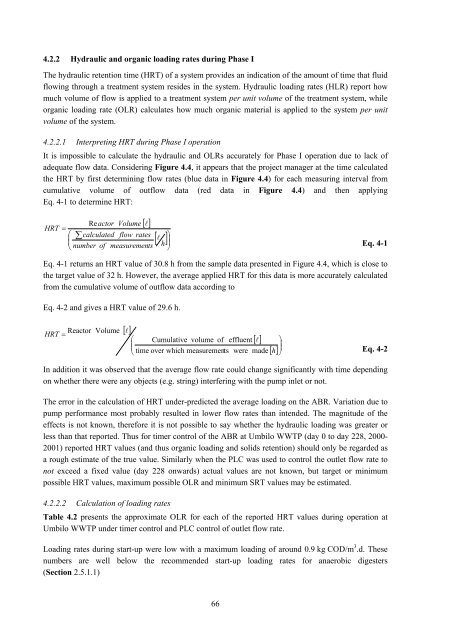analysis of a pilot-scale anaerobic baffled reactor treating domestic ...
analysis of a pilot-scale anaerobic baffled reactor treating domestic ...
analysis of a pilot-scale anaerobic baffled reactor treating domestic ...
You also want an ePaper? Increase the reach of your titles
YUMPU automatically turns print PDFs into web optimized ePapers that Google loves.
4.2.2 Hydraulic and organic loading rates during Phase I<br />
The hydraulic retention time (HRT) <strong>of</strong> a system provides an indication <strong>of</strong> the amount <strong>of</strong> time that fluid<br />
flowing through a treatment system resides in the system. Hydraulic loading rates (HLR) report how<br />
much volume <strong>of</strong> flow is applied to a treatment system per unit volume <strong>of</strong> the treatment system, while<br />
organic loading rate (OLR) calculates how much organic material is applied to the system per unit<br />
volume <strong>of</strong> the system.<br />
4.2.2.1 Interpreting HRT during Phase I operation<br />
It is impossible to calculate the hydraulic and OLRs accurately for Phase I operation due to lack <strong>of</strong><br />
adequate flow data. Considering Figure 4.4, it appears that the project manager at the time calculated<br />
the HRT by first determining flow rates (blue data in Figure 4.4) for each measuring interval from<br />
cumulative volume <strong>of</strong> outflow data (red data in Figure 4.4) and then applying<br />
Eq. 4-1 to determine HRT:<br />
[] l<br />
Reactor<br />
Volume<br />
HRT =<br />
⎛<br />
⎜ ∑calculated<br />
flow rates<br />
⎝ number <strong>of</strong> measurements<br />
[ l<br />
⎞ ] ⎟ h<br />
⎠<br />
66<br />
Eq. 4-1<br />
Eq. 4-1 returns an HRT value <strong>of</strong> 30.8 h from the sample data presented in Figure 4.4, which is close to<br />
the target value <strong>of</strong> 32 h. However, the average applied HRT for this data is more accurately calculated<br />
from the cumulative volume <strong>of</strong> outflow data according to<br />
Eq. 4-2 and gives a HRT value <strong>of</strong> 29.6 h.<br />
HRT =<br />
Reactor Volume<br />
[] l<br />
Eq. 4-2<br />
In addition it was observed that the average flow rate could change significantly with time depending<br />
on whether there were any objects (e.g. string) interfering with the pump inlet or not.<br />
The error in the calculation <strong>of</strong> HRT under-predicted the average loading on the ABR. Variation due to<br />
pump performance most probably resulted in lower flow rates than intended. The magnitude <strong>of</strong> the<br />
effects is not known, therefore it is not possible to say whether the hydraulic loading was greater or<br />
less than that reported. Thus for timer control <strong>of</strong> the ABR at Umbilo WWTP (day 0 to day 228, 2000-<br />
2001) reported HRT values (and thus organic loading and solids retention) should only be regarded as<br />
a rough estimate <strong>of</strong> the true value. Similarly when the PLC was used to control the outlet flow rate to<br />
not exceed a fixed value (day 228 onwards) actual values are not known, but target or minimum<br />
possible HRT values, maximum possible OLR and minimum SRT values may be estimated.<br />
4.2.2.2 Calculation <strong>of</strong> loading rates<br />
Table 4.2 presents the approximate OLR for each <strong>of</strong> the reported HRT values during operation at<br />
Umbilo WWTP under timer control and PLC control <strong>of</strong> outlet flow rate.<br />
Loading rates during start-up were low with a maximum loading <strong>of</strong> around 0.9 kg COD/m 3 .d. These<br />
numbers are well below the recommended start-up loading rates for <strong>anaerobic</strong> digesters<br />
(Section 2.5.1.1)<br />
[] l<br />
[] ⎟⎟<br />
⎛ Cumulative volume <strong>of</strong> effluent ⎞<br />
⎜<br />
⎝ time over which measurements<br />
were made h ⎠
















